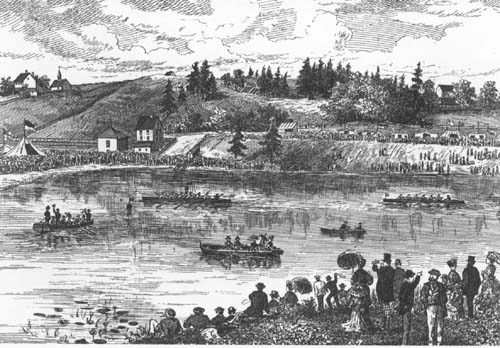|
It is after this eleven year hiatus that we see the official
Regatta Committee coming to the forefront, meeting
on a regular basis, and recruiting members of the community who may be able
to further the needs of the Committee. The Committee would set the date
of the races, the rules, and would even match the crews in competition. It seems as
though there was a concerted effort by the Committee to ensure the public were
able to enjoy themselves as thorughly as possible. It is also important to note that after
the haitus records of the Regatta were kept with greater care.
|

Early illustration of Regatta from Canadian Illustrated News(Year:1875 Size: 51kB, Source: Regatta Museum).
|
On the 22nd of August, 1874, there was a sculling race that took place on the lake between a local resident named Richard Squires of Broad Cove, and a man from Nova Scotia named George Ferguson. Apparently the Nova Scotian felt he could easily beat the local resident but was proven wrong when Squires beat him by half the length of the pond. After such an impressive display, the admiring friends of Squires paraded him through town on their shoulders - while he was still in his boat.
The Placentia Giants
Probably one of the most uplifting stories of the era and indeed of the entire history of the St.John's Regatta is that of the Seven Placentia Giants. This crew built their own boat and carried it on their backs to St.John's over a rough trail nearly 90 kilometers long, as no roads existed at the time. The team consisted of brothers Philip, Daniel, John, Patrick and Moses Morrissey, and their friend James Whalen, all of whom were over 6 feet tall! Their Coxswain was Mr. Edward Sinnott who had actually built the boat - though he had never built any sort of boat before! They won the Fisherman's Race with a time of 10 minutes, 28 seconds, defeating teams from Torbay, Outer Cove, Harbour Grace, and St. John's, as well as a British warship moored in port. The crew was so impressive that Sir John Glover, the Governor, asked for them to be brought to him, and he added a gold Sovereign to their winnings.
The legend concludes with the crew returning to Placentia with their boat on their backs. In actual fact, however, the Placentia was sold for $112.00 on the 13th of August at the Market House in St.John's. One hundred and ten years later, in 1987, the crew was honoured with an induction into the Regatta Hall of Fame.
A sign of the times
On August 3rd, 1882 an article appeared in The Evening Telegram commenting on the low turnout of people at that years Regatta:
"The number of tents on the north side appeared to be fully
one-third less then last year, and the attendance was
certainly by far the smallest we have ever witnessed there
on such an occasion. But no intelligent man could have
mistaken the cause. The reckless, perfidious policy of the
Whiteway, Shea government had unsettled the public
mind, and pleasure-taking, in view of the imminent
financial danger by which the colony is now threatened,
seemed, with a great many, to preclude the possibility
of real enjoyment"
- The Evening Telegram
Thursday 3 August, 1882
This was a sign of the times. Similarly, the Regatta has often proven to
give a fair indication of the economic times within Newfoundland and
Labrador. When the economy is in a slump, people tend not to spend as much
money or travel to see the Regatta. The economic hard times tend to pass and
the Regatta carries on through both feast and famine.
Thursday 3 August, 1882
(continued on Page 2)





